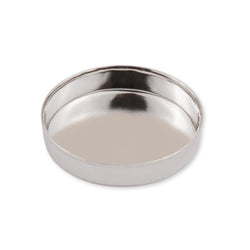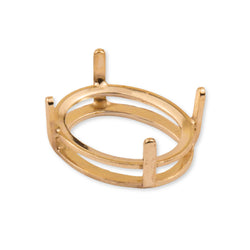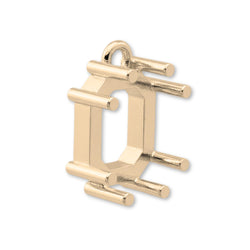inställningar
Inställningar för smyckestillverkning
Vår inställningskollektion erbjuder allt från klassiska infattningsmuggar till sofistikerade klo- och stiftinställningar, lämpliga för en rad lösa stenar och smyckesdesigner. Oavsett om du tillverkar ett delikat hänge, en statement-ring eller eleganta örhängen, ger våra inställningar den perfekta basen, vilket säkerställer att dina ädelstenar visas upp vackert och säkras ordentligt.
Vanliga frågor
En smyckeinställning är den del av ett smycke som håller och säkrar ädelstenen på plats.
Det är en viktig komponent i smyckesdesign, inte bara för dess funktionella syfte att hålla ädelstenen säker utan också för dess roll i smyckets övergripande estetik.
Det finns olika typer av inställningar, såsom ram, stift, klo och korginställningar, var och en erbjuder ett annat utseende och metod för att säkra stenen.
Valet av inställning beror på smyckets stil, ädelstenens typ och skärning samt önskad nivå av säkerhet och synlighet för stenen.
Att sätta en lös ädelsten innefattar flera steg:
- Välj rätt inställning: Välj en inställning som passar storleken, formen och typen av din ädelsten. Inställningen ska komplettera stenen och ge tillräckligt stöd.
- Förbered inställningen: Om det är en stiftinställning, justera försiktigt stiften så att de passar storleken på stenen. För en raminställning, se till att fälgen har rätt storlek för att omsluta stenen.
- Placera stenen: Placera försiktigt ädelstenen i inställningen. Den ska sitta plant och säkert.
- Säkra stenen: För stiftinställningar, använd ett sättningsverktyg för att böja stiften över stenen och håll den på plats. För en raminställning, använd en ramrulle eller tryckare för att trycka metallkanten över stenens kanter.
- Finish och polering: När stenen är säker, kontrollera om det finns några vassa kanter eller ojämnheter. Polera inställningen för en jämn finish.
Bezel settings are a type of jewellery setting where a metal rim encircles the gemstone, holding it securely in place. These settings are used in various jewellery pieces, including rings, pendants, and earrings. Bezel settings provide excellent protection for gemstones and offer a sleek, modern look. They are ideal for those seeking a secure and durable setting, particularly in jewellery that is worn frequently.
Claw settings, also known as prong settings, use metal prongs to hold the gemstone in place, allowing more light to pass through the stone compared to bezel settings. This results in enhanced brilliance and sparkle. Bezel settings, on the other hand, surround the gemstone with a continuous metal rim, offering more protection but less light exposure. Claw settings are popular for engagement rings and statement pieces where the gemstone's brilliance is a key feature.
To choose the right size setting for your gemstone, measure the stone's diameter and depth accurately. The setting should be slightly larger than the stone's dimensions to ensure a secure fit. It's important to consider the shape of the gemstone as well—round stones fit well in round bezel cups, while oval stones require oval settings. Ensure that the setting complements the stone's size and shape to enhance the overall design.
A basket setting is a type of jewellery setting that uses a lattice-like framework to hold the gemstone in place. This setting provides a secure hold while allowing maximum light exposure to the stone, enhancing its brilliance. Basket settings are ideal for rings, earrings, and pendants where the gemstone's visibility and sparkle are important. They are particularly popular for designs that require a balance between security and aesthetics.
Yes, sterling silver settings are durable enough for everyday jewellery, provided they are properly cared for. Sterling silver is a strong metal that can withstand daily wear, making it an excellent choice for rings, pendants, and earrings. To maintain its durability and shine, it’s important to clean sterling silver regularly and store it in a dry, tarnish-resistant environment.
To set a gemstone into a bezel cup setting, place the stone into the cup and gently press it down to ensure a snug fit. Using a bezel pusher or burnisher, carefully push the metal rim over the edge of the gemstone, working your way around the stone evenly. This secures the stone within the setting. Ensure the metal is flush with the stone’s surface to create a smooth and secure finish.
Choosing between sterling silver and gold settings depends on your personal style, the type of gemstone, and the desired aesthetic of the jewellery piece. Sterling silver offers a sleek, modern look and is more affordable, making it suitable for everyday wear. Gold settings, available in yellow, white, and rose gold, provide a luxurious and timeless appearance, making them ideal for special occasions or high-end jewellery. Consider the colour and value of the gemstone when selecting the metal to ensure a harmonious design.
Claw settings are ideal for engagement rings because they allow maximum light exposure to the gemstone, enhancing its brilliance and sparkle. The prongs securely hold the stone in place while minimizing the amount of metal visible, making the gemstone the focal point. Claw settings also offer versatility in design, accommodating various stone shapes and sizes, which makes them a popular choice for showcasing diamonds and other precious stones in engagement rings.
To properly secure a gemstone in a claw setting, place the stone in the setting and gently press down to seat it. Using prong pliers or a prong pusher, carefully bend each prong over the stone’s edge, starting with opposing prongs to ensure even pressure. Check that the prongs are tightly secured against the stone without gaps, and ensure they are evenly spaced around the stone. This will keep the gemstone securely in place while maximizing its exposure to light.
Bezel settings are favoured for their modern look and secure hold, while claw settings are popular for enhancing a gemstone's brilliance. Basket settings are appreciated for their combination of security and elegance, making them a top choice for rings, pendants, and earrings.
Den "bästa" stensättningen beror på olika faktorer, inklusive typen av smycke, ädelstenens egenskaper och personliga preferenser.
- Bezel Settings är kända för sin säkerhet och är bra för stenar som kräver extra skydd.
- Prong eller Claw Settings släpper in mer ljus i stenen, förstärker dess briljans och är lämpliga för att visa upp facetterade ädelstenar.
- Korginställningar erbjuder en balans mellan säkerhet och synlighet, lämplig för en mängd olika stentyper.
Bezel cups protect gemstones by encasing them in a metal rim, which shields the stone's edges from impact and wear. This secure setting is particularly beneficial for softer gemstones or those intended for daily wear, as it reduces the risk of chipping or damage. The bezel setting also helps keep the gemstone firmly in place, providing both durability and a sleek, contemporary look.
Basket settings for earrings offer several advantages, including enhanced light exposure to the gemstone, which increases its brilliance. The open design of a basket setting allows more light to enter the stone from multiple angles, resulting in a more sparkling appearance. Additionally, basket settings provide a secure hold for the gemstone while maintaining an elegant and delicate look, making them ideal for both studs and drop earrings.
A bezel setting is right for your jewellery project if you prioritize security and protection for the gemstone. Bezel settings are ideal for stones that need extra durability, such as those used in rings or bracelets worn daily. They also work well for achieving a sleek, modern aesthetic. If your design requires a setting that minimizes exposure to light while offering maximum protection, a bezel setting is an excellent choice.
The primary difference between round and oval bezel cups is their shape. Round bezel cups are designed to hold round or oval gemstones, offering a symmetrical, classic look. Oval bezel cups, on the other hand, are elongated to accommodate oval-shaped gemstones, providing a unique and elegant appearance. The choice between round and oval bezel cups depends on the shape of your gemstone and the desired style of your jewellery design.
To select the best setting for a statement ring, consider the size and shape of your gemstone, as well as the desired visual impact. Claw settings are ideal for showcasing large, brilliant stones, while bezel settings offer a more secure and protective option. Basket settings combine elegance with security, making them suitable for intricate designs. Choose a setting that complements the gemstone and enhances its presence in the overall design.
Yes, our settings are versatile and can be used for both modern and traditional jewellery designs. Bezel settings offer a sleek, contemporary look, while claw settings are more classic and timeless. Basket settings provide a sophisticated and elegant option suitable for both styles. The choice of metal and setting type allows for creativity in adapting the design to either modern or traditional aesthetics.
To set stones in jewellery settings, you will need a variety of tools, including bezel pushers, prong pliers, and burnishers. A bezel pusher helps to secure the stone in a bezel setting, while prong pliers are used to tighten prongs around the stone in claw settings. A burnisher is used to smooth and polish the metal around the stone, ensuring a secure fit and a professional finish. Additionally, a jeweller’s loupe can help you inspect the setting and stone placement for accuracy.
To ensure a secure fit for your gemstone in a basket setting, carefully place the stone in the setting and adjust the prongs using prong pliers. Gently push the prongs over the edges of the gemstone, ensuring they are evenly spaced and tightly secured. Check that the stone is stable and that the prongs are firmly in place without any gaps. This will keep the gemstone securely in the setting while allowing it to shine.
Yes, jewellery settings can be customized for bespoke designs. Our collection offers a range of settings that can be tailored to fit specific gemstones or design requirements. Whether you need a unique metal finish, a specific size, or a combination of setting types, customizing your jewellery settings allows you to create one-of-a-kind pieces that reflect your personal style and creativity.
Using recycled sterling silver in jewellery offers several environmental benefits, including reducing the demand for newly mined silver, which helps to conserve natural resources and reduce environmental degradation. Recycled silver also reduces energy consumption and greenhouse gas emissions associated with mining and refining processes. By choosing recycled sterling silver, you support sustainable and ethical jewellery making practices that contribute to a more eco-friendly industry.
Claw settings, also known as prong settings, enhance the brilliance of gemstones by allowing maximum light to pass through the stone. The metal prongs hold the gemstone securely in place while exposing most of its surface, including the sides and bottom, to light. This increased light exposure creates more sparkle and brilliance, making claw settings particularly popular for showcasing diamonds and other precious gemstones in engagement rings and statement jewellery pieces.
When choosing a setting for a delicate gemstone, consider the level of protection the setting provides. Bezel settings are ideal for delicate gemstones as they encase the stone in metal, offering the most protection against impact and damage. If you prefer a setting that allows more light to pass through the stone, a claw or basket setting can be used, but ensure that the prongs are strong and secure to prevent the stone from becoming loose. The hardness of the gemstone should also be considered, as softer stones require more protective settings.
To create a custom piece using bezel and claw settings, start by selecting the gemstone(s) you wish to showcase. Decide on the overall design and how each setting will complement the stone. Bezel settings can be used for stones that require extra protection or for a sleek, modern look, while claw settings are ideal for stones where brilliance and light exposure are key. Combine the two settings in a design that balances protection with visual impact, such as using a bezel setting for the main stone and claw settings for accent stones. Work with a skilled jeweller to ensure that the settings are precisely fitted and securely hold the gemstones in place.
The main differences between bezel and basket settings are their structure and the level of protection they provide. Bezel settings encase the gemstone in a continuous metal rim, offering maximum protection by securing the stone on all sides. This setting style is ideal for everyday jewellery and softer gemstones. Basket settings, on the other hand, use a lattice-like framework to hold the gemstone in place, allowing more light to pass through the stone. While basket settings offer less protection than bezel settings, they enhance the gemstone’s brilliance and are often used for rings, pendants, and earrings where the stone’s visual impact is a priority.
Yes, our jewellery settings are versatile and can be used for both precious and semi-precious stones. Whether you are setting a diamond, sapphire, or an amethyst, our settings are designed to securely hold and beautifully showcase a wide range of gemstones. The choice of setting—bezel, claw, or basket—can be matched to the specific characteristics of the stone, ensuring that it is both protected and aesthetically pleasing. Our settings are crafted to accommodate various stone sizes and shapes, making them suitable for custom jewellery designs featuring any type of gemstone.



